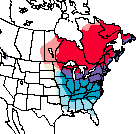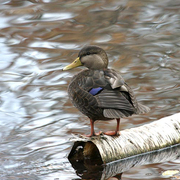American Black Duck
General Description
The American Black Duck is a large duck that closely resembles a female Mallard. The Black Duck's body color is darker than that of a Mallard, and the head color is slightly lighter. In flight, the Black Duck can be distinguished by the solid purplish-blue patch on its wing (lacking the white edges found on the Mallard) and the contrast between the dark body and upperwings and the light underwing linings. Black Ducks are unusual among dabbling ducks in that males and females are almost identical, distinguishable in the breeding season only by the bright yellow bill of the male.
Habitat
American Black Ducks are historically found in forested wetlands, tidewater areas, and coastal marshes of eastern North America.
Behavior
Black Ducks congregate in large groups in the fall and winter, when pair bonds form. Pairs remain together through the winter and into the breeding season. Once the eggs are laid and the female begins incubation, the pair dissolves. At this time the males molt their feathers and go through a month-long period of flightlessness while their new feathers grow in. Once the young fledge, the females go through the same flightless molt. By August, both sexes are able to fly again.
Diet
Black Ducks dabble for food, tipping their bodies up and dunking their heads to forage under water. They occasionally forage on land. When in coastal marshes, they are more omnivorous than most dabbling ducks, with mollusks, crustaceans, and arthropods making up nearly half of their diet. The other half is seeds, tubers, and other vegetable matter more typical of the group
Nesting
American Black Ducks nest on or near the ground, generally close to water. Dense clumps of vegetation help to obscure shallow depressions lined with plant material and feather down. The female incubates 9 to 10 eggs, rarely leaving the nest during the final few days before hatching. Immediately after hatching, chicks can swim and find food on their own.
Migration Status
Black Ducks winter farther north and migrate later than most dabbling ducks. Throughout their range, they migrate varying distances, although the small population formerly in Washington was resident year round.
Conservation Status
A small, feral population was present in Washington from the late 1960s through the mid-1990s. This population appears to have been extirpated in recent years due to competition and hybridization with Mallards, a factor that also contributes to their decline in their traditional range. Since American Black Ducks are not native to Washington, this decline is not of major conservation concern in our state.
When and Where to Find in Washington
A few remnant birds may still be present near the Everett sewage ponds (Snohomish County), where the feral population once was. Vagrants also turn up occasionally in various locations. It is usually difficult to determine whether these birds are escapees from captive populations or true vagrants, wandering from their traditional range.
North American Range Map


Family Members
 Fulvous Whistling-DuckDendrocygna bicolor
Fulvous Whistling-DuckDendrocygna bicolor Taiga Bean-GooseAnser fabalis
Taiga Bean-GooseAnser fabalis Greater White-fronted GooseAnser albifrons
Greater White-fronted GooseAnser albifrons Emperor GooseChen canagica
Emperor GooseChen canagica Snow GooseChen caerulescens
Snow GooseChen caerulescens Ross's GooseChen rossii
Ross's GooseChen rossii BrantBranta bernicla
BrantBranta bernicla Cackling GooseBranta hutchinsii
Cackling GooseBranta hutchinsii Canada GooseBranta canadensis
Canada GooseBranta canadensis Mute SwanCygnus olor
Mute SwanCygnus olor Trumpeter SwanCygnus buccinator
Trumpeter SwanCygnus buccinator Tundra SwanCygnus columbianus
Tundra SwanCygnus columbianus Wood DuckAix sponsa
Wood DuckAix sponsa GadwallAnas strepera
GadwallAnas strepera Falcated DuckAnas falcata
Falcated DuckAnas falcata Eurasian WigeonAnas penelope
Eurasian WigeonAnas penelope American WigeonAnas americana
American WigeonAnas americana American Black DuckAnas rubripes
American Black DuckAnas rubripes MallardAnas platyrhynchos
MallardAnas platyrhynchos Blue-winged TealAnas discors
Blue-winged TealAnas discors Cinnamon TealAnas cyanoptera
Cinnamon TealAnas cyanoptera Northern ShovelerAnas clypeata
Northern ShovelerAnas clypeata Northern PintailAnas acuta
Northern PintailAnas acuta GarganeyAnas querquedula
GarganeyAnas querquedula Baikal TealAnas formosa
Baikal TealAnas formosa Green-winged TealAnas crecca
Green-winged TealAnas crecca CanvasbackAythya valisineria
CanvasbackAythya valisineria RedheadAythya americana
RedheadAythya americana Ring-necked DuckAythya collaris
Ring-necked DuckAythya collaris Tufted DuckAythya fuligula
Tufted DuckAythya fuligula Greater ScaupAythya marila
Greater ScaupAythya marila Lesser ScaupAythya affinis
Lesser ScaupAythya affinis Steller's EiderPolysticta stelleri
Steller's EiderPolysticta stelleri King EiderSomateria spectabilis
King EiderSomateria spectabilis Common EiderSomateria mollissima
Common EiderSomateria mollissima Harlequin DuckHistrionicus histrionicus
Harlequin DuckHistrionicus histrionicus Surf ScoterMelanitta perspicillata
Surf ScoterMelanitta perspicillata White-winged ScoterMelanitta fusca
White-winged ScoterMelanitta fusca Black ScoterMelanitta nigra
Black ScoterMelanitta nigra Long-tailed DuckClangula hyemalis
Long-tailed DuckClangula hyemalis BuffleheadBucephala albeola
BuffleheadBucephala albeola Common GoldeneyeBucephala clangula
Common GoldeneyeBucephala clangula Barrow's GoldeneyeBucephala islandica
Barrow's GoldeneyeBucephala islandica SmewMergellus albellus
SmewMergellus albellus Hooded MerganserLophodytes cucullatus
Hooded MerganserLophodytes cucullatus Common MerganserMergus merganser
Common MerganserMergus merganser Red-breasted MerganserMergus serrator
Red-breasted MerganserMergus serrator Ruddy DuckOxyura jamaicensis
Ruddy DuckOxyura jamaicensis

